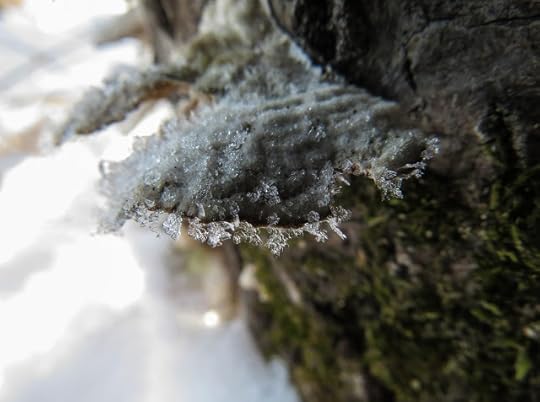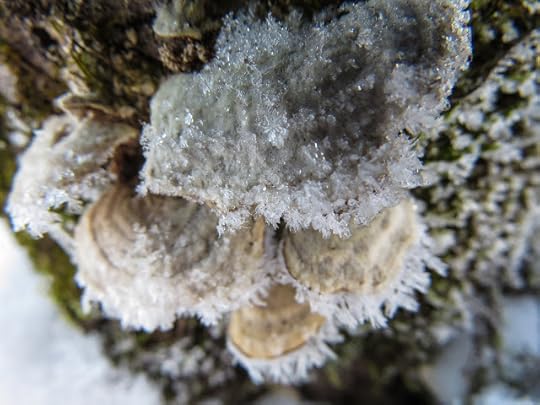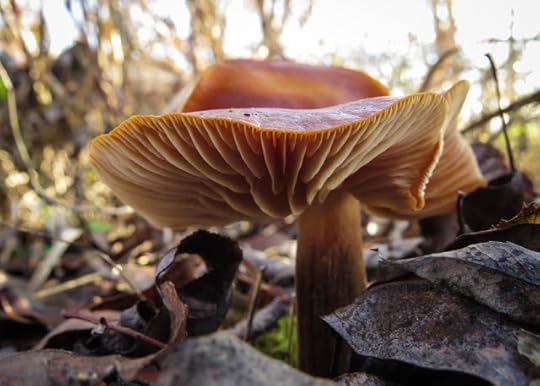Ariel Gordon's Blog, page 13
December 3, 2015
deer yard
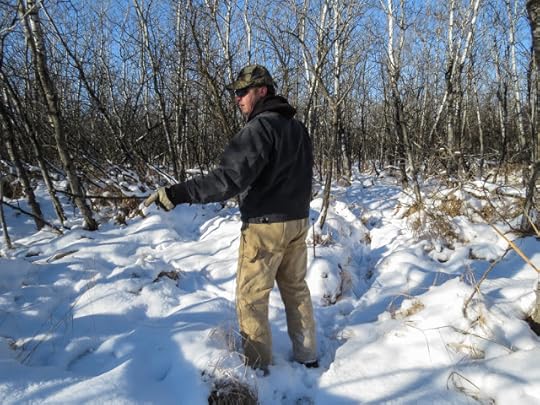
* * *
So Jim Daher is the husband of my friend, YA writer Anita Daher. I've spent time with Jimmy over the last few years because spouses now get invited along to what had been a small group of women writers who went regularly for dim sum.
So the first thing I learned about Jim was that he was good a sulking over missed dim sum. Over time, I learned that Jimmy also likes physics, bourbon, and deerhunting. I've been at their house and had Jim's excellent moosemeat chili and deer sausage.
And so, when I decided to try to walk the forest only on its deerpaths last week for an essay I'm writing, I thought it might be useful to bring Jim along. He'd just returned from his annual deer hunt a week or so before and had been posting bloody pictures from the hunt and the post-hunt process of making deer into neat packages of meat to FB.
I told him to wear what he'd normally have on to hunt. "Face paint and everything??" he replied.
I said that that might be a bit too far. When he showed up at Assiniboine Forest, a few days later, he'd chosen not to wear his orange vest either, but everything else was from his hunting kit.
He held out his hands: "Look, my gloves still have deer blood on them."
We tramped around for two hours, following deer paths, both new and well-used. Which meant lots of up-and-over fallen logs, plowing through tall grasses, and making our way between trees in dense patches of woods.
We talked about how deer use space. We talked about how he uses that information to hunt them. We talked about how he fills and empties his freezer every year with deer meat. About what he's not interested in hunting.
We didn't see a single other person on our walk, but we did find deerbeds, piles of pellets, and then, two does and a buck, munching on grasses. We got very close to the deer: probably the closest I've ever been. (Jim muttered that it was a four-point buck and something about kill shots....)
The most surprising thing in that space was the large number 'rabbit highways,' as Jim called them, narrow but well-used paths. (Considering it had just snowed the night before, these were especially surprising...)
As we made our way back to our cars, we followed the well-established deer path that parallels Grant Avenue, the deer waiting to cross the street or even just avoiding traffic.
Published on December 03, 2015 11:10
frosting
Published on December 03, 2015 10:37
winter mushrooming
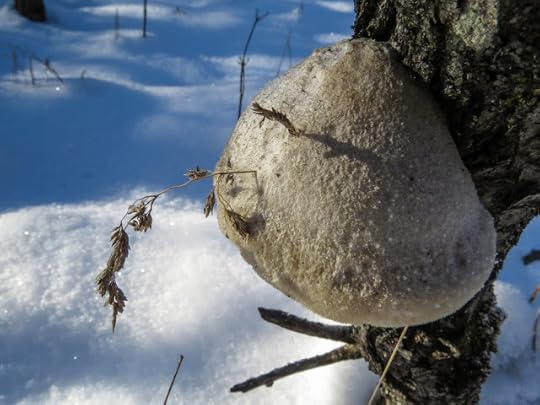
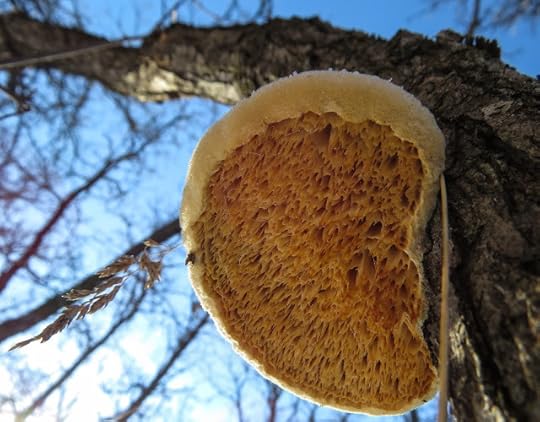 All photos November 27, 2015. Assiniboine Forest, Winnipeg, MB.* * *
All photos November 27, 2015. Assiniboine Forest, Winnipeg, MB.* * *Winter mushrooming is finding mushrooms tucked away on the protected side of nurse logs. Is finding sturdy conks on thin-trunked trees, like this one. Is ice crystals extending the edges of the mushrooms.
I like how this mushroom has a stalk of grass growing through it. I like how the top and bottom views are so different.
Published on December 03, 2015 10:24
November 26, 2015
The Puritan
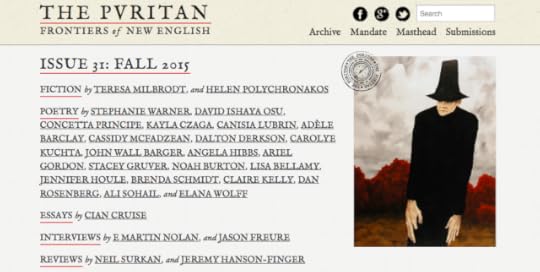
* * *
And then, a day later, I have another poem in The Puritan. Months and months go by without a new poem of mine in the world and then there are two in two days!?!
Today's poem is "Local Smoke," which I wrote in June and submitted while I was at the Deep Bay Cabin. It's an occasional poem, in that it was written based on a specific event, a particular place and time.
The occasion for "Local Smoke," was the forest fire smoke from drought-dry Saskatchewan and Alberta that blew into Winnipeg in early June that co-incided with the stabbing of a teenage boy at a Winnipeg high school. Both events caused me look at the world slightly differently, to shift my perception of normal, and I wanted to mark that somehow.
Interestingly, it was also a poem that came together very quickly, during a walk home from work.
Which is how I found myself standing in the no-man's land between the turn from Stafford onto Academy and the Maryland Street Bridge, scribbling madly—and awkwardly, leaning on the St. Mary's Academy fence—in my notebook.
My thanks to editors at the The Puritan for putting my poem in such excellent company. It's wonderful to see and hear (because editors get contributors to submit audio recordings of accepted poems...) my work alongside that of writer friends like Brenda Schmidt and John Wall Barger as well as that of young poets whose work I'm just getting to know like Cassidy McFadzean and Kayla Czaga.
Fun!
Published on November 26, 2015 13:14
November 25, 2015
Weak Wood
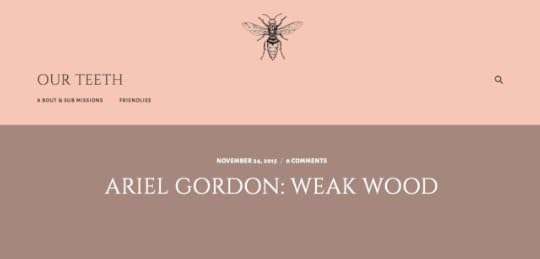
* * *
So a suite of found poems called "Weak Wood" was published on the Our Teeth blog.
Run by poet/parent/prof kevin mcpherson eckhoff, Our Teeth has the following mandate: "converses with/about/around/within/underneath/beside/without contemporary verses, diverses, perverses!"
While I don't usually co-mingle with experimental poets, kevin and I recognize each other as poets. Which is more than enough for us to be able to work with and also alongside each other.
But when Kevin asked that I submit something months ago, I was swamped. So I put it off and put it off and then, finally, had a look at current work to see if there was anything I could send.
And I had this suite of poems I'd composed while at the Deep Bay Cabin back in June/July, based on my reading of Donald Culross Peattie's A Natural History of North American Trees.
At the time, I was trying to learn more about the 24 species of trees that are native to Manitoba. I was also trying to jam some names for the coniferous trees that surrounded the cabin into my head. After a few sessions with A Natural History of North American Trees, I was most struck by the contrast between Peattie's lyrical writing about the beauty of trees and his listing of their uses by the lumber industry.
Of course, I gravitated towards the trees that were categorized by lumberjacks as useless—i.e. weak wood. First, because the useless trees happen to be among my favourites, and second, because I realized that I am usually surrounded by copy paper, particle board, and MDF.
Basically, I pulped Peattie's mini-essays and built strange little structures—found poems—out of them.
It was great fun but the poems weren't successful, to my mind, until kevin had a look. He helped me push them further that I could have done on my own.
It reminded me, again, why working with editors is so essential to writing. The best editors don't say "THIS IS WRONG. DO IT THIS WAY," they say "Hmm. Have you thought about this? This section here is especially intriguing...."
So: new poems from me, about trees. Also: submit to Our Teeth, because that kevin is a good nut.
Published on November 25, 2015 12:12
November 21, 2015
Out-of-Town-Authors: Elizabeth Ross
I met Elizabeth Ross at Palimpsest Press Night at Toronto's Another Story Bookshop in 2014. It was a full night of reading: Patricia Young and I performed alongside Palimpsest editors Jim Johnstone and Dawn Kresan.
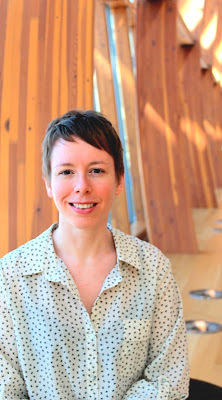 After the reading, Elizabeth—Liz—came up to me and said that she'd read Hump, which was unusual enough in and of itself to be memorable, and that Palimpsest would be publishing her first book soon.
After the reading, Elizabeth—Liz—came up to me and said that she'd read Hump, which was unusual enough in and of itself to be memorable, and that Palimpsest would be publishing her first book soon.
Liz wasn't able to go for the traditional after-reading drink that night, as her small children were waiting for her at home. I remained curious about her and her book-to-be, so I'm really glad, now, to have the chance to chat with her...
So, Liz, what do you want people to know about Kingdom?
It’s part coming-of-age story, part map. It deals with many kingdoms—of course, the heart and the head, but also pathologies, geographies, and histories.
As a writer (i.e. someone whose artistic practice is predicated on time spent alone) how do you approach readings? What do you get out of them?
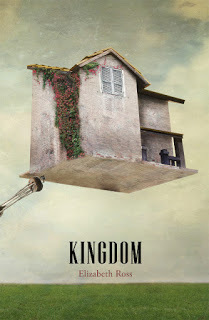 (Hopefully I’m interpreting this question’s framework properly.) Reading my own work doesn’t make me nervous. Maybe I’m not a capital “R” Romantic; maybe as a teacher I’m used to speaking in front of large rooms of people; maybe I feel safe speaking out of the poem’s container. Generally I see readings as a part of the job. I like them. There’s the oral history and traditional practice of poetry (Purdy’s “Say the Names” leaps immediately to mind), and there’s also the buzz I get hearing another poet read. And it’s nice to be in a room with like-minded people, poets and poetry appreciators. I wish I could get out to more readings.
(Hopefully I’m interpreting this question’s framework properly.) Reading my own work doesn’t make me nervous. Maybe I’m not a capital “R” Romantic; maybe as a teacher I’m used to speaking in front of large rooms of people; maybe I feel safe speaking out of the poem’s container. Generally I see readings as a part of the job. I like them. There’s the oral history and traditional practice of poetry (Purdy’s “Say the Names” leaps immediately to mind), and there’s also the buzz I get hearing another poet read. And it’s nice to be in a room with like-minded people, poets and poetry appreciators. I wish I could get out to more readings.
Tell me about that strange object/phenomena called ‘the first book.’
As a creative writing student, I had the impression that many writers see the first book as being synonymous with regret, or as exposing some great wound or embarrassment, or as something to get over with, like bungee jumping naked. Critically, the books seem to be received as the next and greatest thing, or largely ignored.
Now that I have published a first book, I don’t really think of it as “the first book”—it’s just a book. I worked hard on it. I don’t think I’ll be embarrassed by it. But I also, at age eighteen, thought similar thoughts about my dragon ying yang tattoo, so who knows. Like my tattoo, perhaps there’s a lot of scrambled lore.
Kingdom explores the idea of “a life of your own,” that thing you’re supposed to acquire as you move from your teenage years onto jobs and houses, pets and spouses. Can you talk a bit about why you wanted to explore this stage, all of us “deer skittish in the bushes”?
I think I’m trying to reconcile an existence built in counterfactuality. I’ve always lived in hypotheticals. And since I can remember I’ve been obsessed with the idea of home, or what exactly makes a home, and wanting to make my own. Even as a kid, I would rearrange my room constantly; I’d play “nest” in the dogwood tree, wedging rock “eggs” into the crotch and sitting on them. Somehow being an adult happened, with no delineation, or stones.
What did you learn about your writing and your process while studying for your MFA at UBC and poetry-editing PRISM International?
There are my pre-kid and post-kid processes. Overall I’ve learned that my process is resilient and flexible, and that writing will happen if I want it to, albeit in less-than expected, or, for some, ideal, circumstances. Since finishing my MFA, I’ve had two kids. So instead of walking and writing and designating think time, I make lunch/drink coffee/bounce/sing/change diapers – and also write. Sometimes I write on the go—sitting on the carpet while my daughters play, or at the table while they eat their breakfasts. When I am able to designate time, more often than not it’s late at night when everyone’s asleep. My walk is pushing the stroller. Really, I have no consistent routine or process. The only thing that has crossed over from my pre-kid days is that at some point, I have to show my work to someone for feedback. And as unpredictable as my writing process is, when I do have uninterrupted time—even ten minutes—I’m super productive; in my MFA days, I would have never taken on anything writing related in such a short time frame.
Editing PRISM was good—not only for my writing, but for my ego. It helped me, as an unpublished grad student, understand that rejections are certainly not personal, or even necessarily a comment on the quality of the work—although they certainly can be. They’re part of a feedback loop that’s cultural, aesthetic, critical, and one I came to realize helps develop good writing. At PRISM, I would reject poems that didn’t fit with the issue’s aesthetic, or because I’d run out of space, or because I’d eaten bacon. Heaven knows. I read carefully and sometimes painfully—editing was a huge responsibility and the framework often unruly. There’s no rubric, that’s for sure. Editing also prepared me to work with an editor on my own work.
Speaking of which, tell me about working with Dawn Kresan at Palimpsest...
Dawn was simultaneously tough and respectful. Working with her showed me that a manuscript truly isn’t a book until it’s been edited by someone who cares about your work, and about poetry overall. In the production process, there’s nothing greater than seeing your editor get excited about a revision— start to finish, she was invested in the manuscript. I’m sure it’s been said before: editor names should appear right next to authors’.
Have you ever been to Winnipeg? What have you heard?
I probably have been to Winnipeg, likely in the early 90s as a teenager slumped in the back of my family’s minivan (see above re. counterfactuals). That was roughly the same year I claimed the thickest and scratchiest wool sweater in existence from my father’s closet, and he told me it was warm enough for Winnipeg winters, which leant the sweater a kind of mythic resonance. As an adult I’ve also heard the classic stories, trees splitting in two from the cold, ice cracking in the river. It sounds like a place I should revisit.
What are you reading right now?
Many poetry collections. Off the top of my head, Floating Is Everything by Sheryda Warrener, Dear Leader by Damian Rogers, Joy Is So Exhausting by Susan Holbrook. Unless they’re long poems, I kind of start and stop with poetry books, taking in a little bit at a time, hitting a point where I need to stop and let poems or ideas do what they need to do, stick my head into another book, repeat, shuffle. I’ve been reading Karen Solie’s The Road In Is Not the Same Road Out for months. The only exception is Michael Dickman, whose books I’ve been pretty much binging on.
What are you writing right now?
I’m writing a collection of poems that examines the ways middle-class motherhood is constructed. I’m also writing a series of loosely-linked personal essays. And many, many grocery lists.
 After the reading, Elizabeth—Liz—came up to me and said that she'd read Hump, which was unusual enough in and of itself to be memorable, and that Palimpsest would be publishing her first book soon.
After the reading, Elizabeth—Liz—came up to me and said that she'd read Hump, which was unusual enough in and of itself to be memorable, and that Palimpsest would be publishing her first book soon.Liz wasn't able to go for the traditional after-reading drink that night, as her small children were waiting for her at home. I remained curious about her and her book-to-be, so I'm really glad, now, to have the chance to chat with her...
So, Liz, what do you want people to know about Kingdom?
It’s part coming-of-age story, part map. It deals with many kingdoms—of course, the heart and the head, but also pathologies, geographies, and histories.
As a writer (i.e. someone whose artistic practice is predicated on time spent alone) how do you approach readings? What do you get out of them?
 (Hopefully I’m interpreting this question’s framework properly.) Reading my own work doesn’t make me nervous. Maybe I’m not a capital “R” Romantic; maybe as a teacher I’m used to speaking in front of large rooms of people; maybe I feel safe speaking out of the poem’s container. Generally I see readings as a part of the job. I like them. There’s the oral history and traditional practice of poetry (Purdy’s “Say the Names” leaps immediately to mind), and there’s also the buzz I get hearing another poet read. And it’s nice to be in a room with like-minded people, poets and poetry appreciators. I wish I could get out to more readings.
(Hopefully I’m interpreting this question’s framework properly.) Reading my own work doesn’t make me nervous. Maybe I’m not a capital “R” Romantic; maybe as a teacher I’m used to speaking in front of large rooms of people; maybe I feel safe speaking out of the poem’s container. Generally I see readings as a part of the job. I like them. There’s the oral history and traditional practice of poetry (Purdy’s “Say the Names” leaps immediately to mind), and there’s also the buzz I get hearing another poet read. And it’s nice to be in a room with like-minded people, poets and poetry appreciators. I wish I could get out to more readings. Tell me about that strange object/phenomena called ‘the first book.’
As a creative writing student, I had the impression that many writers see the first book as being synonymous with regret, or as exposing some great wound or embarrassment, or as something to get over with, like bungee jumping naked. Critically, the books seem to be received as the next and greatest thing, or largely ignored.
Now that I have published a first book, I don’t really think of it as “the first book”—it’s just a book. I worked hard on it. I don’t think I’ll be embarrassed by it. But I also, at age eighteen, thought similar thoughts about my dragon ying yang tattoo, so who knows. Like my tattoo, perhaps there’s a lot of scrambled lore.
Kingdom explores the idea of “a life of your own,” that thing you’re supposed to acquire as you move from your teenage years onto jobs and houses, pets and spouses. Can you talk a bit about why you wanted to explore this stage, all of us “deer skittish in the bushes”?
I think I’m trying to reconcile an existence built in counterfactuality. I’ve always lived in hypotheticals. And since I can remember I’ve been obsessed with the idea of home, or what exactly makes a home, and wanting to make my own. Even as a kid, I would rearrange my room constantly; I’d play “nest” in the dogwood tree, wedging rock “eggs” into the crotch and sitting on them. Somehow being an adult happened, with no delineation, or stones.
What did you learn about your writing and your process while studying for your MFA at UBC and poetry-editing PRISM International?
There are my pre-kid and post-kid processes. Overall I’ve learned that my process is resilient and flexible, and that writing will happen if I want it to, albeit in less-than expected, or, for some, ideal, circumstances. Since finishing my MFA, I’ve had two kids. So instead of walking and writing and designating think time, I make lunch/drink coffee/bounce/sing/change diapers – and also write. Sometimes I write on the go—sitting on the carpet while my daughters play, or at the table while they eat their breakfasts. When I am able to designate time, more often than not it’s late at night when everyone’s asleep. My walk is pushing the stroller. Really, I have no consistent routine or process. The only thing that has crossed over from my pre-kid days is that at some point, I have to show my work to someone for feedback. And as unpredictable as my writing process is, when I do have uninterrupted time—even ten minutes—I’m super productive; in my MFA days, I would have never taken on anything writing related in such a short time frame.
Editing PRISM was good—not only for my writing, but for my ego. It helped me, as an unpublished grad student, understand that rejections are certainly not personal, or even necessarily a comment on the quality of the work—although they certainly can be. They’re part of a feedback loop that’s cultural, aesthetic, critical, and one I came to realize helps develop good writing. At PRISM, I would reject poems that didn’t fit with the issue’s aesthetic, or because I’d run out of space, or because I’d eaten bacon. Heaven knows. I read carefully and sometimes painfully—editing was a huge responsibility and the framework often unruly. There’s no rubric, that’s for sure. Editing also prepared me to work with an editor on my own work.
Speaking of which, tell me about working with Dawn Kresan at Palimpsest...
Dawn was simultaneously tough and respectful. Working with her showed me that a manuscript truly isn’t a book until it’s been edited by someone who cares about your work, and about poetry overall. In the production process, there’s nothing greater than seeing your editor get excited about a revision— start to finish, she was invested in the manuscript. I’m sure it’s been said before: editor names should appear right next to authors’.
Have you ever been to Winnipeg? What have you heard?
I probably have been to Winnipeg, likely in the early 90s as a teenager slumped in the back of my family’s minivan (see above re. counterfactuals). That was roughly the same year I claimed the thickest and scratchiest wool sweater in existence from my father’s closet, and he told me it was warm enough for Winnipeg winters, which leant the sweater a kind of mythic resonance. As an adult I’ve also heard the classic stories, trees splitting in two from the cold, ice cracking in the river. It sounds like a place I should revisit.
What are you reading right now?
Many poetry collections. Off the top of my head, Floating Is Everything by Sheryda Warrener, Dear Leader by Damian Rogers, Joy Is So Exhausting by Susan Holbrook. Unless they’re long poems, I kind of start and stop with poetry books, taking in a little bit at a time, hitting a point where I need to stop and let poems or ideas do what they need to do, stick my head into another book, repeat, shuffle. I’ve been reading Karen Solie’s The Road In Is Not the Same Road Out for months. The only exception is Michael Dickman, whose books I’ve been pretty much binging on.
What are you writing right now?
I’m writing a collection of poems that examines the ways middle-class motherhood is constructed. I’m also writing a series of loosely-linked personal essays. And many, many grocery lists.
Published on November 21, 2015 17:45
November 17, 2015
Southwood Lands
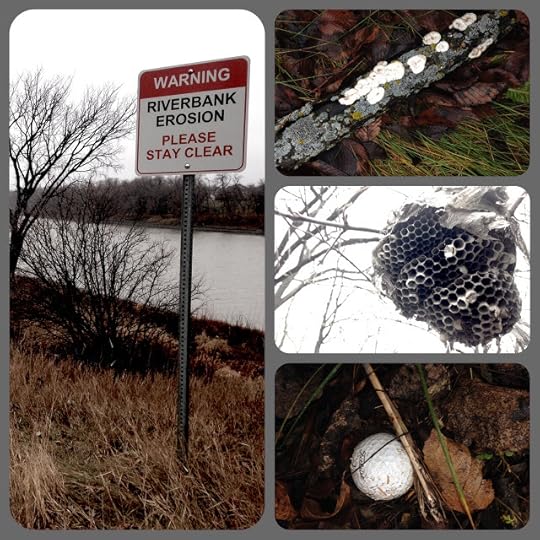
* * *
From a lunchtime prowl in the rainy Southwood Lands, which is the decommissioned golf course adjacent to the University of Manitoba. I was hoping to see a raptor or two—I've had good luck there over the past few years—but the dead trees were empty.
There was a single pair of ducks in one of the retention ponds. Other than that, Southwood felt emptied out. No geese. A few small songbirds. There was just the rain and chill in the air.
So I walked hard and listened to the rain on the hood of my jacket and waited for my body to warm up. There were more dead trees but the grasses were green and there were new mushrooms, slicked down by rain.
The Southwood Lands are scrubby, overgrown, beautiful. So: more like a forest and less like a golf course. The only thing is: it doesn't feel like a healthy forest.
I'm committed to walking Southwood until it's gone.
(The bottom image, if you're wondering, is of a golf ball in it's natural habitat. I found it at the base of a grove of trees...)
Published on November 17, 2015 19:38
November 16, 2015
Grownups Read
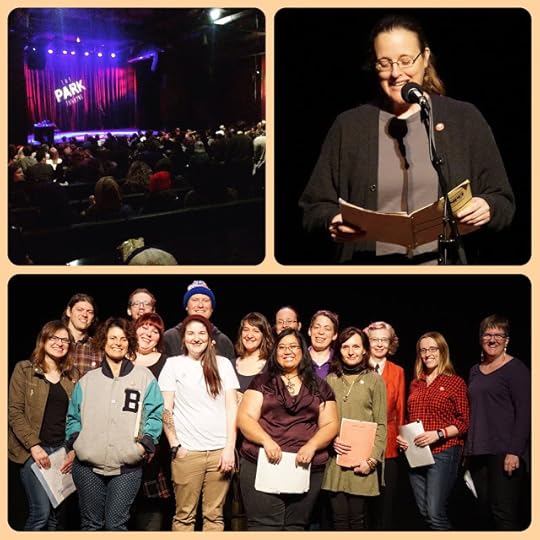
* * *
So I read at the Sunday matinee of Grownups Read Things They Wrote as Kids (or GRTTWak), which is a national CBC radio show and podcast.
I was one of sixteen people who volunteered to read five minutes' worth of letters and journal entries and notes and school newspaper articles and comics and stories and poems. (And it wasn't even me reading the poems!)
I read from my grade six (maybe seven...) Language Arts journal. Which I composed, under duress, in either 1984 or 1985.
I had just come from the forest, so I was rumpled and sweaty, but instead of going home and showering, I'd sat in the car in the Assiniboine Forest parking lot and wrote for an hour and then rehearsed my reading a few times. I booted it down to the Park Theatre with just enough time to spare to get a sandwich, so I wouldn't have a hunger headache by the time my reading started.
And I was rumpled and sweaty-looking, because I'd left both my make up bag and brush at home, but I had so much fun reading, that it didn't matter. And everyone seemed to like it; everyone was laughing and groaning and got a second round of applause after I'd finished.
It was strange to go from being alone all morning to being so intensely in company, but both were peak "alone" and "in company" experiences, so I won't complain....
My thanks to the producers of GRTTWaK, Jenna and Dan, and to the Park Theatre, which seemed to be exactly the right size for the event.
I wasn't able to attend the evening show, but I'm sure it was equally memorable.
If I make it into the podcast—they have twice or three times the amount of content they need, so there's no guarantee—I'll post the link.
Published on November 16, 2015 07:59
November 15, 2015
And one more
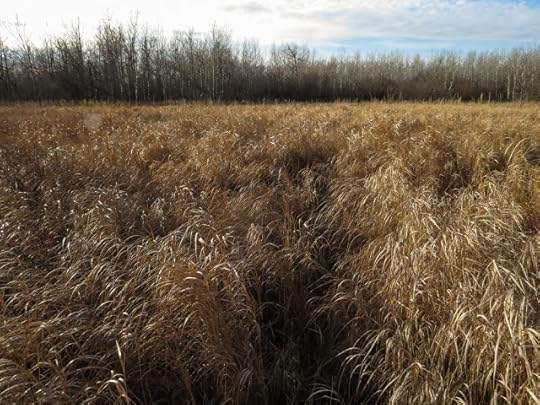 Photo November 13, 2015. Assiniboine Forest, Winnipeg, MB.* * *
Photo November 13, 2015. Assiniboine Forest, Winnipeg, MB.* * *The clearing created by an old fire twenty years ago, whose half-burned logs somehow kept out the trembling aspen and most other colonizers, is nearly gone now. A 2012 brushfire ignited by an out-of-control bonfire mostly finished the job. I liked this clearing. We saw a lost pair of moose there once. And I used to photograph a colony of pixie cups and other slow-growing teeny-tiny lichens on a log halfway in. I also liked it because it was noticeably different than the forest that surrounded it.
I've been photographing the clearing as it recovers from the fire, so I can keep track of how it's changed...
The other day, it was full of thigh-high blonde grasses and, from the path whose end you can see in the picture, I'm not the only one who likes to come and stand at the edge of the clearing.
Published on November 15, 2015 08:53
gilled
Published on November 15, 2015 08:39

